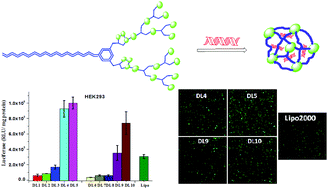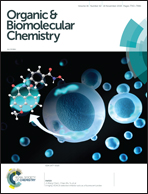Structure–activity relationship of novel low-generation dendrimers for gene delivery†
Abstract
Structure–activity relationship (SAR) studies are very critical to design ideal gene vectors for gene delivery. However, It is difficult to obtain SAR information of low-generation dendrimers due to the lack of easy structural modification ways. Here, we synthesized a novel family of rigid aromatic backbone-based low-generation polyamidoamine (PAMAM) dendrimers. According to the number of primary amines, they were divided into two types: four-amine-containing PAMAM (DL1–DL5) and eight-amine-containing PAMAM (DL6–DL10). Due to the introduction of a rigid aromatic backbone, the low-generation PAMAM could be modified easier by different hydrophobic aliphatic chains. Several assays were used to study the interactions of the PAMAM dendrimers with plasmid DNA, and the results revealed that they not only had good DNA binding ability but also could efficiently condense DNA into spherical-shaped nanoparticles with suitable sizes and zeta potentials. The SAR studies indicated that the gene-transfection efficiency of the synthesized materials depended on not only the structure of their hydrophobic chains but also the number of primary amines. It was found that four-amine-containing PAMAM prepared from oleylamine (DL5) gave the best transfection efficiency, which was 3 times higher than that of lipofectamine 2000 in HEK293 cells. The cellular uptake mechanism mediated by DL5 was further investigated, and the results indicated that DL5/DNA complexes entered the cells mainly via caveolae and clathrin-mediated endocytosis. In addition, these low-generation PAMAMs modified with a single hydrophobic tail showed lower toxicity than lipofectamine 2000 in MC3T3-E1, MG63, HeLa, and HEK293 cells. These results reveal that such a type of low-generation polyamidoamines might be promising non-viral gene vectors, and also give us clues for the design of safe and high-efficiency gene vectors.

- This article is part of the themed collection: Chemical Biology in OBC

 Please wait while we load your content...
Please wait while we load your content...